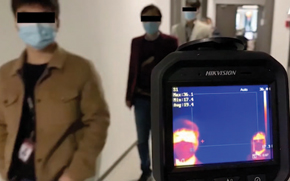Innovative technological approaches to workplace and public confidence and safety will become increasingly important, says Hikvision, which is among video product manufacturers to offer temperature screening thermal solutions.
This is the company says a thermal-imaging based system designed for the contact-free preliminary detection of elevated skin surface temperatures. Using thermal and conventional lenses and sensors, it provides automatic alerts when anyone passing the camera exhibits a temperature in excess of a pre-configured range, allowing them to be measured and assessed at the door.
The accuracy of the camera standalone system is ±0.5°C; it can be enhanced with a blackbody calibrator to increase the accuracy to ±0.3°C and capable of screening multiple people at once. It employs AI, to minimise false alarms caused by heat from other sources, and comes in a variety of formats, including turret and bullet-style cameras, a handheld version, and a metal detector door with integrated thermal camera, the product firm adds.
Employee confidence
Hikvision says that its temperature screening systems are already being used across hospitals, enterprise head offices, construction sites, government buildings, meat processing plants, nursing homes, food and drug distribution centres, construction sites, and in retail. In many cases their use has formed part of the organisation’s strategy for returning employees to work.
But before any organisation makes a decision about implementing this screening technology, it’s worth being clear about what it can and cannot do, the firm adds.
Thermal screening cameras can:
– Detect surface skin temperature on a non-contact basis, reducing risk
– Indicate if that detected temperature falls outside of the pre-configured range, providing a first line of screening for a facility
– Screen a high volume of people in a short timeframe
– Provide an audit trail of steps taken to assist with health, safety and welfare compliance
Thermal screening cameras can’t:
– Detect coronavirus;
– Detect a fever.
These aren’t medical devices: they provide preliminary screening in order to offer reassurance and confidence for those entering a facility, with risk for screening staff minimised due to the non-contact nature of the system.
Further considerations
Once a decision has been made to implement a temperature screening solution, a number of factors should be taken into account, including: company approvals, set-up and management guidance, communications to staff (and, if necessary, the wider public), and a data protection assessment.
Also consider:
– Completion of consent forms for staff;
– A policy for screening visitors to the facility;
– Who will monitor the screening? Will they need special conflict management training?
– Will visitors be asked to leave or to undergo further clinical screening?
– Will a specific facility be required for this further screening or for personnel feeling unwell?
A guide for businesses provides further advice on issues including GDPR (data protection). You can download the guide from:
https://www.hikvision.com/uk/solutions/solutions-by-application/temperature-screening/user-guide-for-process-and-implementation/.










